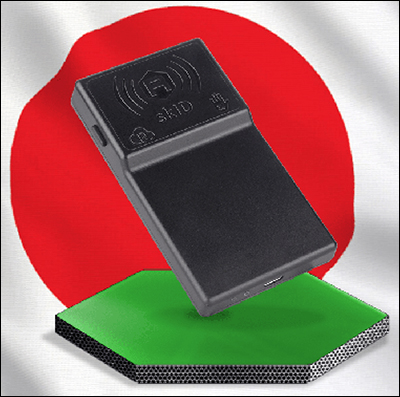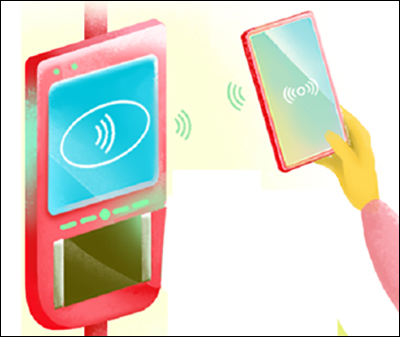- CAEN RFID Reader Meets Japanese Radio Regulations
- Swissbit, Micron Partner on IoT Edge-to-Cloud Security
- NXP Intros BLE Wireless Audio Solution
- Reyax Technology Unveils NFC RFID Reader Module
- Semtech, Amazon Web Services Team Up on IoT Track-and-Trace
- HiveMQ Enables IoT Data Integration to AWS
- LoRa Alliance Offers Certification for SCHC Over LoRaWAN
Dec 08, 2022Presented here are recent news announcements in the radio frequency identification and Internet of Things industries.
CAEN RFID Reader Meets Japanese Radio Regulations
 CAEN RFID has announced that its portable skID RAIN RFID reader, which comes with an integrated antenna for medium-range applications, now complies with Japan's radio regulation. The skID (models R1280IE and R1280IU) will be made available to Japanese companies, as well as to global organizations with sites in that country, willing to implement UHF RFID solutions in their business. The reader contains an internal rechargeable battery and can operate in wired mode using a USB cable, or in wireless mode through the Bluetooth interface.
CAEN RFID has announced that its portable skID RAIN RFID reader, which comes with an integrated antenna for medium-range applications, now complies with Japan's radio regulation. The skID (models R1280IE and R1280IU) will be made available to Japanese companies, as well as to global organizations with sites in that country, willing to implement UHF RFID solutions in their business. The reader contains an internal rechargeable battery and can operate in wired mode using a USB cable, or in wireless mode through the Bluetooth interface.
The skID can be affixed to a smartphone via magnets, 3M Dual Lock or SP-Connect. It is designed to transform an Apple iPhone or an Android-based smartphone into a mobile terminal for automatic identification solutions, the company reports, making it suitable for inventory management, mobile workers, and service and maintenance. The device is compliant with the UHF EPC Class 1 Gen 2 and ISO 18000-63 RFID standards, with ETSI and FCC versions available. It features an integrated circular-polarized antenna, an ergonomic form factor, battery power, and iPhone and iPad compatibility.
The reader, part of CAEN RFID's easy2read product line, is compatible with the Windows 8/10, Windows CE/Mobile, Android and iOS operating systems. The device supports Bluetooth Low Energy (BLE) and Bluetooth classic communication, allowing usage flexibility, including the HID profile for keyboard emulation. An Impinj R2000 chipset provides fast reading speeds, and the device can be used in dense reader and tag environments.
Swissbit, Micron Partner on IoT Edge-to-Cloud Security
 Swissbit, a provider of memory and storage solutions, is collaborating with Micron to expand the reach of the latter's Authenta technology for Internet of Things (IoT) security. Swissbit will integrate Authenta tech into select security and storage solutions, making its root-of-trust secure element features available to customers in the industrial automation, automotive, NetCom and medical technology sectors.
Swissbit, a provider of memory and storage solutions, is collaborating with Micron to expand the reach of the latter's Authenta technology for Internet of Things (IoT) security. Swissbit will integrate Authenta tech into select security and storage solutions, making its root-of-trust secure element features available to customers in the industrial automation, automotive, NetCom and medical technology sectors.
The first Swissbit storage product with integrated Authenta tech will be a microSD card, the companies report, and they plan to introduce an embedded version in the future. Authenta adds secure element features to flash memory to strengthen system-level security. It combines a unique device-specific identity, as well as the measurement capability necessary for in-memory secure boot, enabling users to authenticate IoT devices directly with a host, whether in the cloud, at the edge or on a device.
Utilizing existing standard flash memory sockets, developers can strengthen system-level cybersecurity without adding additional hardware components. Authenta is designed to boost cybersecurity and facilitate zero-touch onboarding deployments. Micron's Authenta Cloud offers silicon-to-cloud onboarding and authentication capabilities. The platform enables real-time, in-field device authentication across supply chains and throughout device lifecycles, offering an open, scalable foundation for cloud-based IoT services.
NXP Intros BLE Wireless Audio Solution
 NXP Semiconductors has announced its NXH3675 Bluetooth audio solution, certified to the Bluetooth 5.3 Low Energy audio standard. The NXH3675 enables multi-stream wireless audio streaming with ultra-low power consumption and latency, the company reports, using an integrated single-chip 2.4 GHz transceiver. According to NXP, 1.3 billion Bluetooth audio-streaming devices were shipped in 2021, with a forecast of 1.5 billion for 2023.
NXP Semiconductors has announced its NXH3675 Bluetooth audio solution, certified to the Bluetooth 5.3 Low Energy audio standard. The NXH3675 enables multi-stream wireless audio streaming with ultra-low power consumption and latency, the company reports, using an integrated single-chip 2.4 GHz transceiver. According to NXP, 1.3 billion Bluetooth audio-streaming devices were shipped in 2021, with a forecast of 1.5 billion for 2023.
The BLE audio standard enables audio sharing, hearing assistance and new use cases beyond what classic Bluetooth audio allows. The device enables developers to create Bluetooth audio products with high-quality audio transmission, broadcasting capabilities, and multiple audio streams and data channels, as well as NXP's audio-streaming protocol. Target applications include gaming headsets, hearing aids, soundbars, TV transmitters, wireless headphones, earbuds, speakers and microphones. Bluetooth 5.3 LE audio certified with Auracast, a broadcast audio communication, enables audio sharing use cases in the 2.4 GHz radio band.
A dedicated Arm Cortex-M0+ supports flexible software link-layer protocols up to the HCI level, enabling multi-stream applications. The system features a dual CoolFlux DSP for audio processing of the LC3 and LC3+ audio encoder-decoder, as well as audio and voice enhancements such as EQ, compression, gain control and mixing. NXP also offers its NXH3675 starter kit, which includes an evaluation kit for debugging and evaluation, gaming headset and dongle application kits, and a software development kit.
Reyax Technology Unveils NFC RFID Reader Module
 IoT solutions provider Reyax Technology has announced its RYRR30I Near Field Communication (NFC) RFID module, a fully integrated, multiprotocol 13.56 MHz device. The company offers Bluetooth, Wi-Fi, LoRa, RFID, GNSS, Cloud, 4G, 5G, NB-IoT and RF modules for Internet of Things solutions. A version of the RYRR30I module supports Apple Wallet VAS and Google SmartTap Pass.
IoT solutions provider Reyax Technology has announced its RYRR30I Near Field Communication (NFC) RFID module, a fully integrated, multiprotocol 13.56 MHz device. The company offers Bluetooth, Wi-Fi, LoRa, RFID, GNSS, Cloud, 4G, 5G, NB-IoT and RF modules for Internet of Things solutions. A version of the RYRR30I module supports Apple Wallet VAS and Google SmartTap Pass.
The protocols can work over a short distance and can be used to present contactless passes independently. When the device is held near an NFC terminal, the latter will initiate receiving the pass information by sending a pass request. Thus, the company explains, users can integrate keys, tickets, gift cards or loyalty cards by tapping their phone. The module supports over-the-air update functionality to simplify firmware updates.
End users need not physically contact or connect to a PC to update the module's firmware. This, according to the company, lowers costs, extends product lifecycles, and ensures reliability and safety. The RYRR30I supports the NFCIP-1 (ISO/IEC 18092) Active P2P standard and comes with integrated protocol handling for ISO15693, ISO14443A, ISO14443B and FeliCa. Built-in programming options make the device suitable for proximity and vicinity identification system applications.
Semtech, Amazon Web Services Team Up on IoT Track-and-Trace
 Semtech, a supplier of analog and mixed-signal semiconductors, has entered into a strategic agreement with Amazon Web Services to license its LoRa Cloud global navigation satellite system (GNSS) geolocation services. This, the companies explain, will help the AWS global developer community build asset-tracking and -monitoring solutions and connect IoT-enabled devices to the cloud via LoRa Edge.
Semtech, a supplier of analog and mixed-signal semiconductors, has entered into a strategic agreement with Amazon Web Services to license its LoRa Cloud global navigation satellite system (GNSS) geolocation services. This, the companies explain, will help the AWS global developer community build asset-tracking and -monitoring solutions and connect IoT-enabled devices to the cloud via LoRa Edge.
AWS IoT Core Device Location is globally available across seven regions, Semtech indicates, and is available for immediate use with AWS IoT Core. The LoRa Edge device-to-cloud solution is a low-power, software-defined platform that provides indoor and outdoor geolocation capability, with a multi-band LoRa and LR-FHSS transceiver supporting global terrestrial and satellite LoRaWAN networks. The scalable solution is suited for many IoT applications, the company reports, including industrial, building, home, agriculture, transportation and logistics.
The LoRa Edge platform enables ultra-low-power devices that can last for years on a single battery, according to Semtech. It offers a single console experience with AWS IoT Core, including LoRa Cloud, with regional availability across seven regions. The technology will be compatible with several hardware devices incorporating LoRa Edge silicon that are either already commercially available, such as those from Semtech and Miromico, or are expected to be made available in the next few months, including those from Tektelic and Mikrotik.
HiveMQ Enables IoT Data Integration to AWS
HiveMQ, a provider of enterprise message-queuing telemetry transport (MQTT) solutions, has announced the availability of its Enterprise Extension for Amazon Kinesis, which allows users to move MQTT data from the broker into AWS using Amazon Kinesis Data Streams. With this release, customers can integrate MQTT data to AWS, Microsoft Azure or Google Cloud, or simultaneously in a multi-cloud environment. The goal, according to the company, is to offer customers a flexible and open foundation for MQTT data transport, regardless of cloud platform.
HiveMQ's platform-agnostic broker offers 100 percent MQTT compliance, the firm explains, as well as efficient network utilization, enterprise-grade security, reliable data delivery and the ability to scale to millions of always-on concurrent connections for a range of IoT applications. The extension framework provides the flexibility to integrate with enterprise systems to support multi-cloud strategies and eliminate vendor lock-in. Other features include indirect support for Amazon Kinesis Data Firehose and Data Analytics, configuration of access credentials and authentication via AWS Identity and Access Management, and continuous support and feature updates.
HiveMQ's MQTT platform has been listed in the Eclipse Foundation's Sparkplug Compatible program. This designation validates the platform as Sparkplug-compliant and -aware, while providing reliable and scalable IIoT messaging support for Industry 4.0 projects. Sparkplug is an open-source software specification for increasing MQTT interoperability in smart manufacturing and Industrial IoT. The spec provides operational technology data with context so it can be integrated with information technology in a bi-directional and interoperable way.
As a founding member of the Foundation's Sparkplug Working Group, HiveMQ helped to develop the Sparkplug 3.0 specification and the Sparkplug Technology Compatibility Kit (TCK). The Sparkplug Compatibility Program allows system integrators and end users to procure devices and software products that are compatible with the specification. HiveMQ used the Eclipse Foundation's TCK to validate conformance to the specification and support for key MQTT/Sparkplug features.
LoRa Alliance Offers Certification for SCHC Over LoRaWAN
The LoRa Alliance, a global association of companies backing the open LoRaWAN standard for IoT low-power wide-area networks (LPWANs), has announced that LoRaWAN certification is now available for end devices using static context header compression (SCHC). Certification is based on the Alliance's technical specifications for IPv6, which enable the deployment of IPv6 over LoRaWAN solutions.
The first applications include smart metering and smart grids, the organization reports. Solutions using LoRaWAN for metering include proactive consumption monitoring, leak-detection warnings, automatic shutoffs, and solutions for balancing electricity supply and demand. LoRaWAN is suitable for identifying and managing unmeasured losses, the company explains, in addition to conserving energy. Benefits can also be achieved for water and gas metering, with LoRaWAN-certified devices communicating via open standards, enabling scale to address these growing markets.
The certification of IPv6 over LoRaWAN using SCHC confirms that an end device meets the functional requirements of the LoRaWAN IPv6 Adaptation Layer Specification TS010-1.0.0. As a prerequisite of SCHC over LoRaWAN certification, end devices must already be LoRaWAN-certified. The full testing suite for SCHC over LoRaWAN has been added to the LoRaWAN Certification Test Tool, now available for download.
The IPv6 adaptation layer facilitates and accelerates the development of secure and interoperable applications over LoRaWAN, according to the LoRa Alliance. IP-based solutions, commonly found in enterprise and industrial solutions, can now be transmitted over LoRaWAN and be integrated with cloud infrastructures, allowing developers to enable Internet-based applications.

